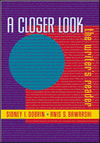
|  |
Feature Summary- Multiple essays by 21 of today's most important writers. Four essays represent each author, so that students can analyze how the individual writer's rhetorical choices change from essay to essay (that is, from rhetorical situation to rhetorical situation). Rick Bass, Annie Dillard, Barbara Ehrenreich, Henry Louis Gates, Jr. Stephen Jay Gould, Barry Lopez, Salman Rushdie, Amy Tan, John Updike, and Alice Walker are among the featured authors.
- Consistent focus on rhetorical situations and choices. Instead of focusing on the writing styles of different authors, A Closer Look focuses on rhetorical considerations, and so is the only composition reader of its type that supports close rhetorical analysis of multiple essays by individual writers, a task much more relevant to composition students' educational needs.
- Essays on writing. The first essay by each professional writer is on an aspect of writing (found under the heading “[author last name] on Writing”), so that students encounter different ways of thinking about and discussing writing, as well as a context for rhetorically analyzing the authors' work.
- Substantial apparatus that focuses on rhetorical considerations. Each author section opens with an introduction to the author that discusses the author's life, body of work, the essays that follow, and initial rhetorical considerations to keep in mind. A contextualizing note with questions for reading (called “At First Glance”) precedes each selection, and “Double Take” questions (that address only the selection at hand) for discussion and writing follow each selection. Each author section concludes with “A Closer Look” questions (that address all of the selections by that author) for discussion and writing; “Looking from Writer to Writer” questions (that address other authors in the text as well as the author immediately at hand); and brief listings of publications by and about the author (“Looking Beyond”).
- Seven essays on writing by student writers. Essays by seven student writers are included in the text, appearing after the last professional author section. All of the student essays have writing as their topic, and each one is preceded by a brief note about the student writer, and an “At First Glance” prompt to guide students' reading. Each selection is followed by “Double Take” questions, just as the professional writer's essays are.
- One essay by each author without reading questions and writing prompts. The last essay by each author appears with only the “At a Glance” note (no other apparatus accompanies the selection), so that students can be challenged to read closely on their own.
- General introduction that includes a brief history of the essay. The book's 10-page introduction covers the importance of connecting reading and writing; the concepts of rhetoric, rhetorical choices, and the rhetorical situation; an overview of A Closer Look and essays in the context of rhetoric and composition courses; and a brief history of the essay, including a detailed portrait of the contemporary essay.
- A unique metaphor to guide students' work. The extended metaphor of looking that informs the book's title and apparatus headings encourages students to look ever more closely at writing, especially multiple pieces of writing by the same author, and to use writing itself (the essay, in particular) as a way of looking more closely at ideas and information.
- Accompanying custom website. The website to accompany A Closer Look provides a wealth of links to author websites, additional writing by the book's authors, critical perspectives, interviews, and other resources.
|
|
|